New Installation
Once all the required pre-requisites are installed, you can start installing ADSS Web RA.
Create two empty databases as a first step on the DBMS (Microsoft SQL Server is supported for the ADSS Web RA application for now), with privileges for ADSS Web RA and ADSS Server.
The ADSS Web RA package MUST be unzipped on to a disk that has sufficient space – a minimum of 100GB is recommended. This is because the product is installed and runs from where the installation package is extracted to. Hence please choose a suitable location and naming structure.
If you extract the installer on Desktop then it will not work so choose a proper drive to extract it.
|
|
1) DO NOT include blank spaces in the installation folder name and path - use hyphen or underscore instead if required. |
ADSS Web RA installer generates all the required database tables and populates the default data required to run the system. Therefore, there is no requirement for separate SQL scripts or equivalent for non-SQL databases.
Once all of the above conditions are satisfied, launch the installer by right-click on the file [WEBRA-Installation-Dir]/setup/install.bat and select Run as administrator from the menu to start installation. You will be directed to the Welcome page.
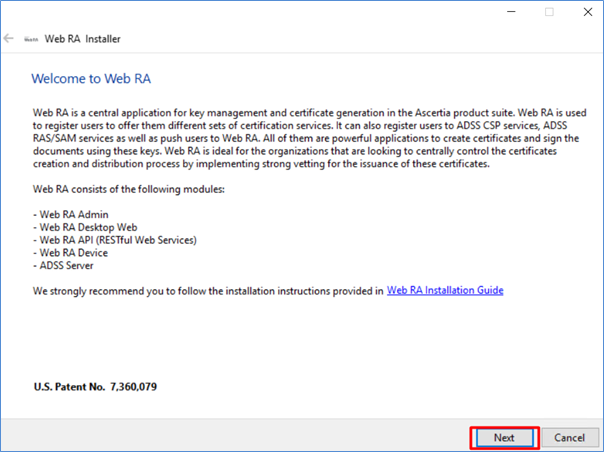
Click Next button to continue.
System requirements screens will appear next to validate if all the required prerequisites are installed or not. If any of ADSS Web RA system dependencies are not found, or not functioning, then Failed status will be shown corresponding to that component on the screen.
|
|
You can only proceed with the installation process once all system-related requirements show Success status on the System Requirements screen. |
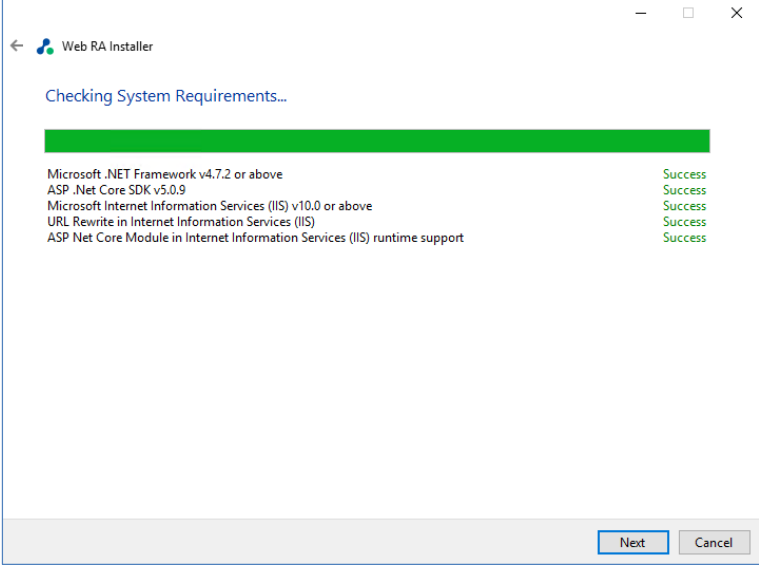
Click Next button to select an installation type.
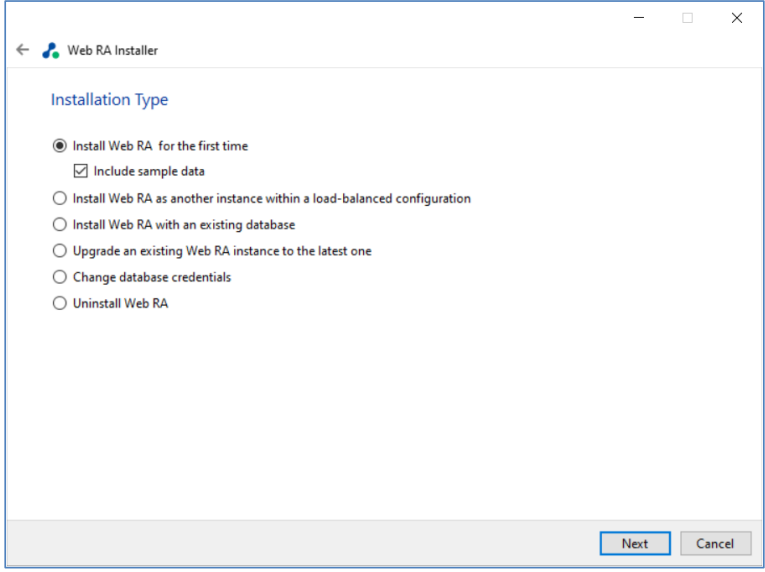
Select the installation type as per your requirement, see following options and select which one best suits you:
- If you are installing ADSS Web RA for the first time or you wish to deploy a fresh installation with a new database, then select “Install Web RA for the first time”.
- The “Install Web RA as another instance within a load-balanced configuration” option will install the Web RA instance in a load-balanced environment to distribute traffic.
- The Install ADSS Web RA with an existing database option will install Web RA against an existing ADSS Web RA database. For example, this option can be used to recover a system from a database back-up.
- If you wish to upgrade an older system to the latest version, then select “Upgrade an existing Web RA instance to the latest one”. Installer supports the upgrade when the base (current) installation is v6.2 or higher.
- The Change database credentials option is used if the database password, user, database name and/or server is changed, and it needs to be updated in Web RA installation.
- Select the last option Uninstall Web RA if you wish to uninstall ADSS Web RA from the system.
Select the first option Install Web RA for the first time. Click Next button to view and accept the license agreement.
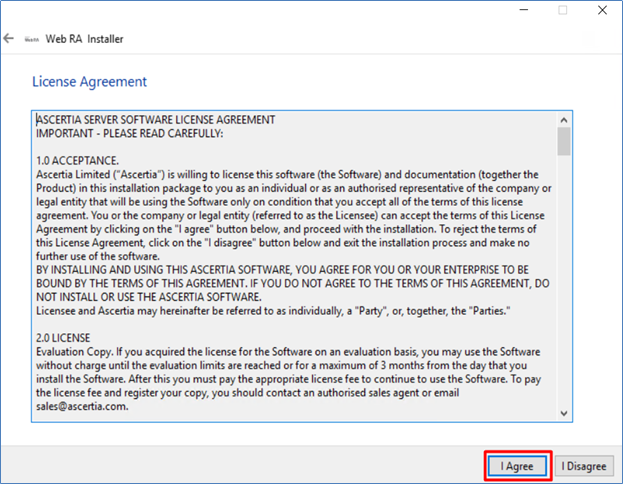
Click on I Agree button to proceed. The next appearing screen will be for ReadMe text.
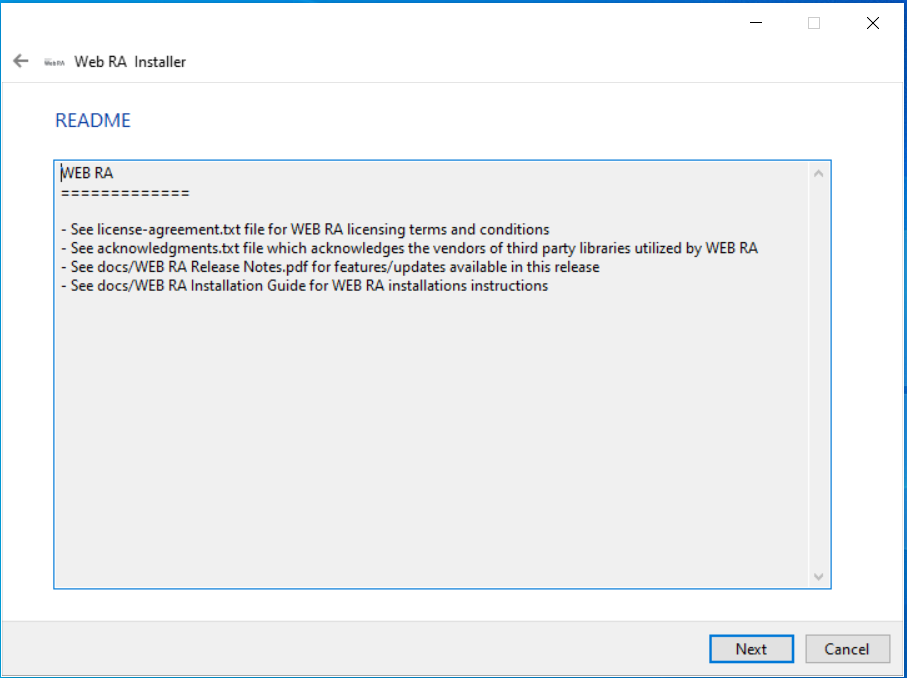
Click Next, the next appearing screen will be for setting up database configurations.
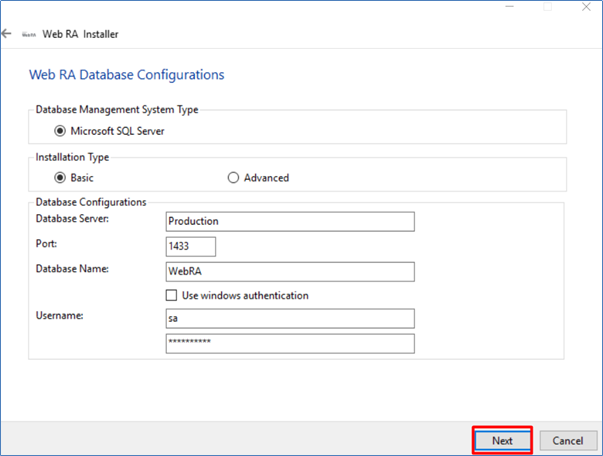
Furthermore, you can either choose to do a basic installation or choose advanced. If this is a basic installation, then use the first option Basic and provide the appropriate Web RA database credentials. The information displayed above is an example and you should configure the relevant settings for your own environment.
|
|
Once you enter the database credentials and select Next, the installer uses the information to test the database connectivity. If the installer can establish the connection with the database, then it will proceed with the installation. A message will appear in case of a connectivity issue. |
The following table details the configuration options:
|
Field |
Description |
|
Database Server |
Database server IP or DNS name. |
|
Port |
Database listening port. For SQL Server the default port is 1433. |
|
Database Name |
Name of the database instance. Note this must exist prior to the installation. |
|
Use Windows Authentication |
If enabled, installer will use the Windows logged in user to communicate with database. You are required to enter password since it will be used in Application Pool to set the Identity against this user for all web instances. By default, the current logged in user will be configured in the Application Pool Identity. If you wish to run ADSS Web RA under a different Windows user, then you need to change it manually. If your requirement is to use SQL Server authentication, then type SQL Server Username and Password in the underneath fields without selecting Windows Authentication. |
|
UserName |
Name of the database user. Note this must exist prior to the installation. It is not required in the case of Windows Authentication. |
|
Password |
Password for the database user. Note this must exist prior to the installation. In case of Windows Authentication, type the password of domain user shown in the Username field to configure the Application Pool Identity in IIS Server for successful communication with SQL Server. |
If you have chosen Advanced for database configurations, then the following screen will be shown.
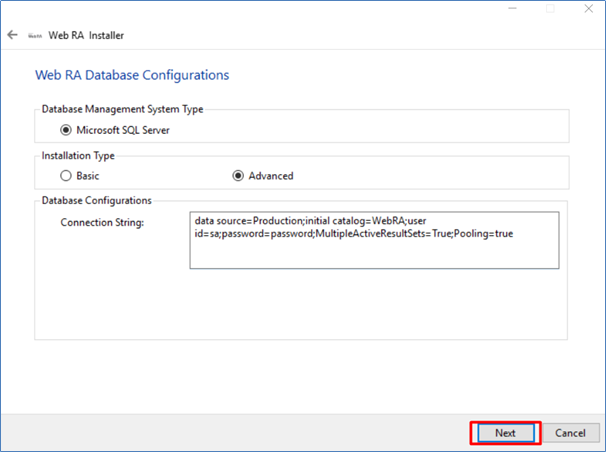
The information displayed above is an example and you should configure the relevant settings for your own environment.
|
|
Once you enter the database credentials and select Next, the installer uses the information to test the database connectivity. If the installer can establish the connection with the database, then it will proceed with the installation. A message will appear in case of any connectivity issue. |
The following table details the configuration options:
|
Field |
Description |
|
Connection String |
The following are sample connection strings for SQL Server:
|
|
|
1) Database User Name must exist prior to the installation. It is not required in case of Windows Authentication. |
Click Next button to select specific modules.
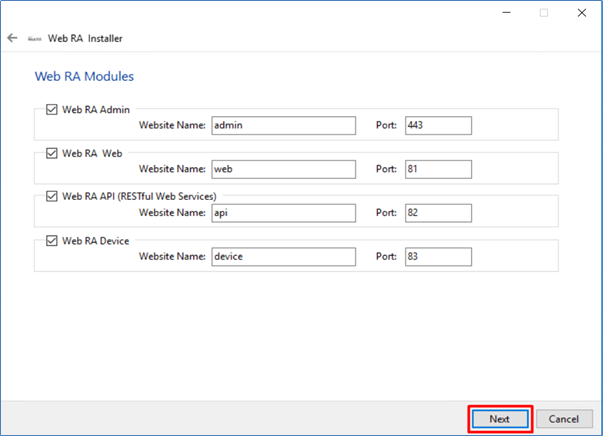
Select the appropriate modules to install the required features. For each selected application, provide the web application name and port. A typical in-house installation of ADSS Web RA should include Admin, Web, API and Device.
The information displayed above is an example, which you may change to suit your environment and organisation preferences. The names will appear as websites under IIS.
The following table details the modules options:
|
Field |
Description |
|
ADSS Web RA Admin |
Used by the Administrators to manage the system wide configurations, service plans, user accounts and access control, etc. |
|
ADSS Web RA Web |
Used to manage certificates issuance, renewal and revocation. |
|
ADSS Web RA API |
RESTful APIs used to integrate ADSS Web RA application with your own business application. |
|
ADSS Web RA Device |
Used to manage device enrolment for certificate issuance, renewal and revocation. |
Click Next button to configure the SMTP server and email settings.
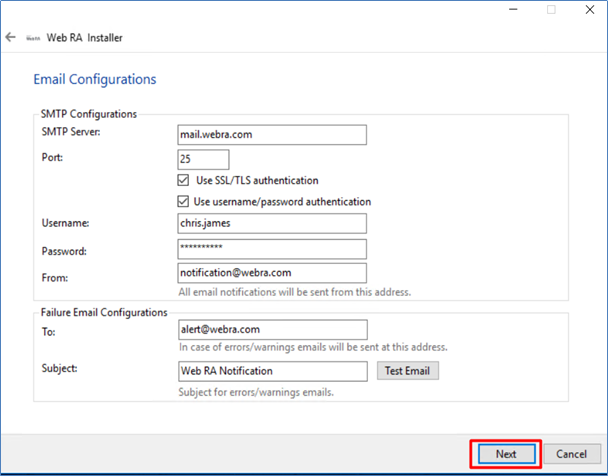
Configure SMTP Server and email settings for your environment. ADSS Web RA must have access to a suitable SMTP server without which users will not be able to receive registration emails that are required to complete the user registration process.
In addition to this, system generated email notifications will not received too. Although the latter will not prevent functionality, but it is not a recommended approach. The information displayed above is an example and you should setup configurations for your own environment.
The configuration items are explained in the following table:
|
Field |
Description |
|
SMTP Server |
Defines the email server address. This email server is used to send email notifications to users as required, such as for account registration, data sharing etc. It is also used for sending notification emails to ADSS Web RA administrators. |
|
Port |
Define the service port for the SMTP mail server. |
|
Use SSL/TLS Authentication |
Select this option if the SMTP mail server requires SSL/TLS. |
|
UserName |
Configure the SMTP mail server username that is used to send ADSS Web RA generated emails. |
|
Password |
Define the password to authenticate the SMTP server. |
|
From |
Configure the From email address that should be used to send notification emails to users and administrators. |
|
To |
Configure the email address where error notifications should be sent. |
|
Subject |
Define a subject line for the notification emails that are sent to the administrator, e.g. ADSS Web RA Alert. |
After configuring these SMTP settings, click Test Email button to verify that SMTP configurations are valid.
Note: If “Include Sample Data” is not selected then SMTP configuration screen will not be shown.
Click the Next button to see the summary and complete the installation:
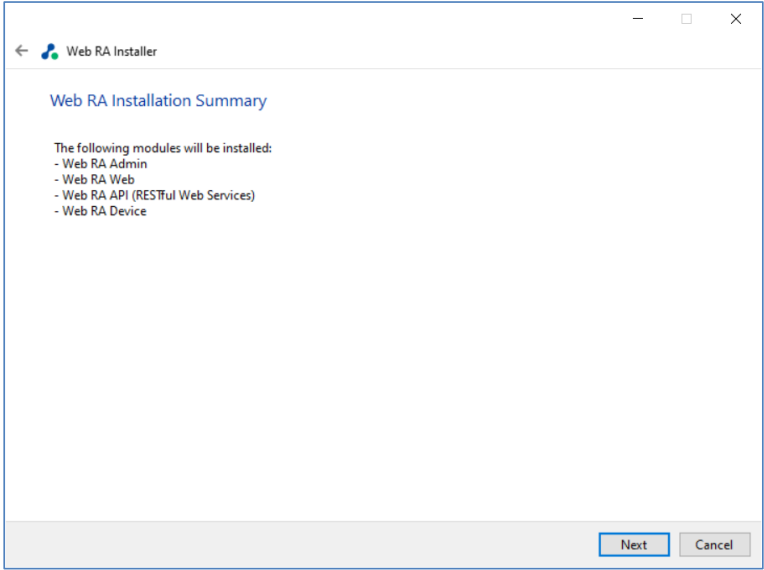
This screen shows the installation summary by listing the different product modules that will be installed.
If you think any listed item is incorrect then use the Back button (arrow towards the top-left of the dialogue box) to correct your choices before proceeding ahead.
Otherwise, click the Next button to continue with the installation.

Click Finish to complete the installation process.

